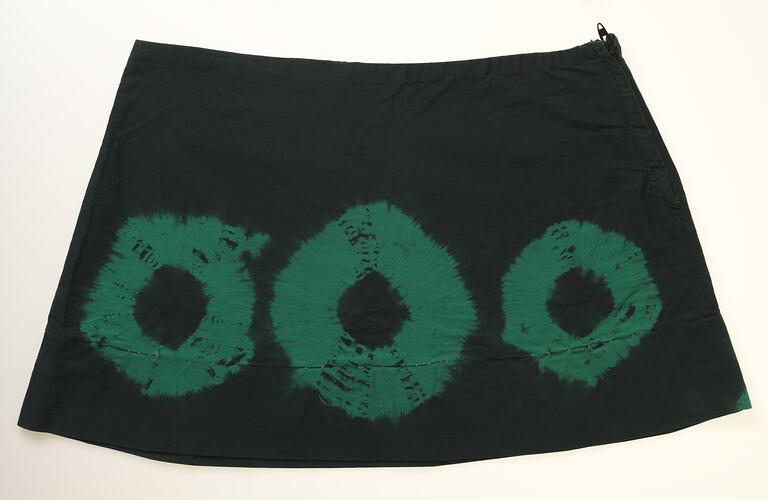Summary
Handmade black and green tie-dyed cotton mini skirt designed and made by Jenny Bannister when she was 13 or 14, while attending Red Cliffs High School in northwest Victoria in 1968.
Jenny was sewing regularly at school and making clothes for herself at home. She first started sewing at just five years old when she was given a toy sewing machine for Christmas. Jenny at first made clothes for her dolls and her dogs.
The tie-dyed mini skirt was influenced by prominent fashion designers at the time, Mary Quant and Prue Acton. Jenny recalls dyeing her fabrics on the gas top stove in her family kitchen and sewing her garments on the kitchen table. Due to the shortness of this skirt, her mother forbade her from wearing it and threatened to burn it. Jenny found out later that her mother had instead hidden the skirt away, where it was found years later. Jenny reflected in 2020: "The miniskirt I was making on the kitchen table, (Mum) said: 'You're not wearing that. You're just not wearing that.' And she confiscated it, and my ballet pointe shoes, and she put them in the incinerator to burn them. But she never did burn them, we found the skirt in my mother's hoardings, after she died! Mum wanted me to be pearls and twin set. Well, I was never going to be pearls and twin set.'
It forms part of the Jenny Bannister archives which document her fashion design education and vocational life from the late 1960s until 2009.
Physical Description
Dark olive green cotton mini skirt featuring three vibrant green tie-dyed rings on the front and back of skirt.The skirt is handmade and the hem is hand stitched using a copper-coloured thread. The copper stitches from the inside hem emanate through to the right side of the fabric.The waist is finished with a narrow facing band sewn to the inside of the skirt using a hand stitch. A small square false pocket is sewn to inside of the waistband. The skirt is fastened with a black metal zip sewn into one of the side seams.
Significance
The Jenny Bannister archive is of national significance, and is arguably the most important fashion design, manufacture and retailing archive still in existence. It documents the career of one of Australia's most significant designers and business women, who kept a thriving company going for almost 40 years, long after her contemporaries had retired or gone bankrupt.
No other collection documents this significant period in Australian fashion and clothing manufacturing so completely and succinctly; from the rise of an independent fashion industry in the 1960s and 70s, complimented by a strong local manufacturing sector, to the moving offshore of most of the manufacture as costs rosed to the eventual bankruptcy and closure of many local labels due to an increased overseas retail presence and rise of online consumerism.
Its importance was recognised by the National Library of Australia, who collected the bulk of her business and manufacture archival material, including 100 of patterns. It was only the second such collection to enter the institution, after that of prominent Sydney designer Linda Jackson.
She was the master of creativity and diversity, able to capture numerous markets, producing the most outlandish and artistic garments as well as highly commercial clothing. as renowned fashion historian and academic Professor Robyn Healy wrote 'Art Clothes, body sculpture, craft, theatrical costume, party clothes or serious fashion - Jenny Bannister's work transcends categorization. Like a New Age traveller, she explores the extraordinary, the primitive and the futuristic, to create garments for for kings, the Mardi Gras of the hip crowd'.
More Information
-
Collection Names
-
Collecting Areas
-
Designer
Jenny Bannister, Red Cliffs, Sunraysia, Victoria, Australia, 1968
-
Maker
-
Classification
-
Category
-
Discipline
-
Type of item
-
Object Dimensions
270 mm (Length), 495 mm (Width), 270 mm (Height)
270mm (full length of garment measured flat) - 325mm (waist width measured flat) - 495 mm (hem width measured flat, edge to edge).
-
Keywords
Clothing, Fashion, Fashion Design, Fashion Industry, Women's Clothing, Innovation & Design, Australian Fashion Industry, Fashion, Fashion Design, Fashion Designers, Fashion Industry, Innovation & Design, Retailing, Clothing, Women's Clothing, Textiles


